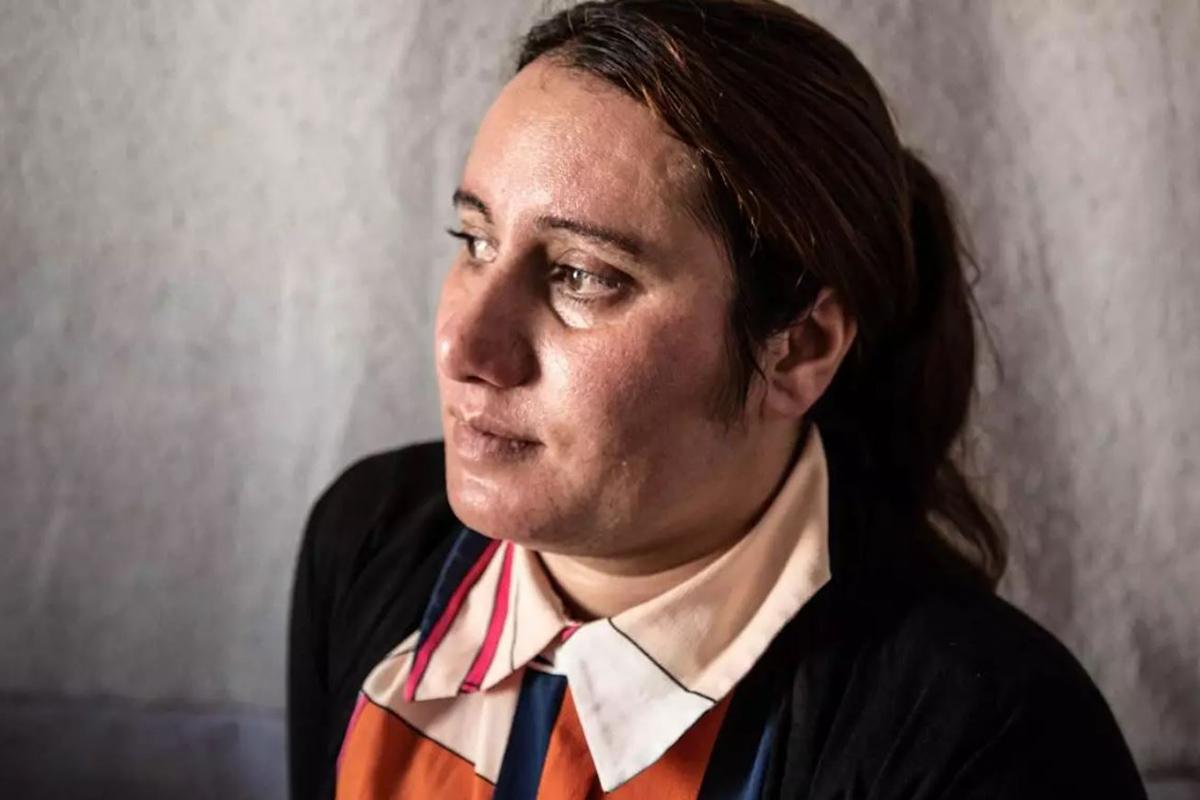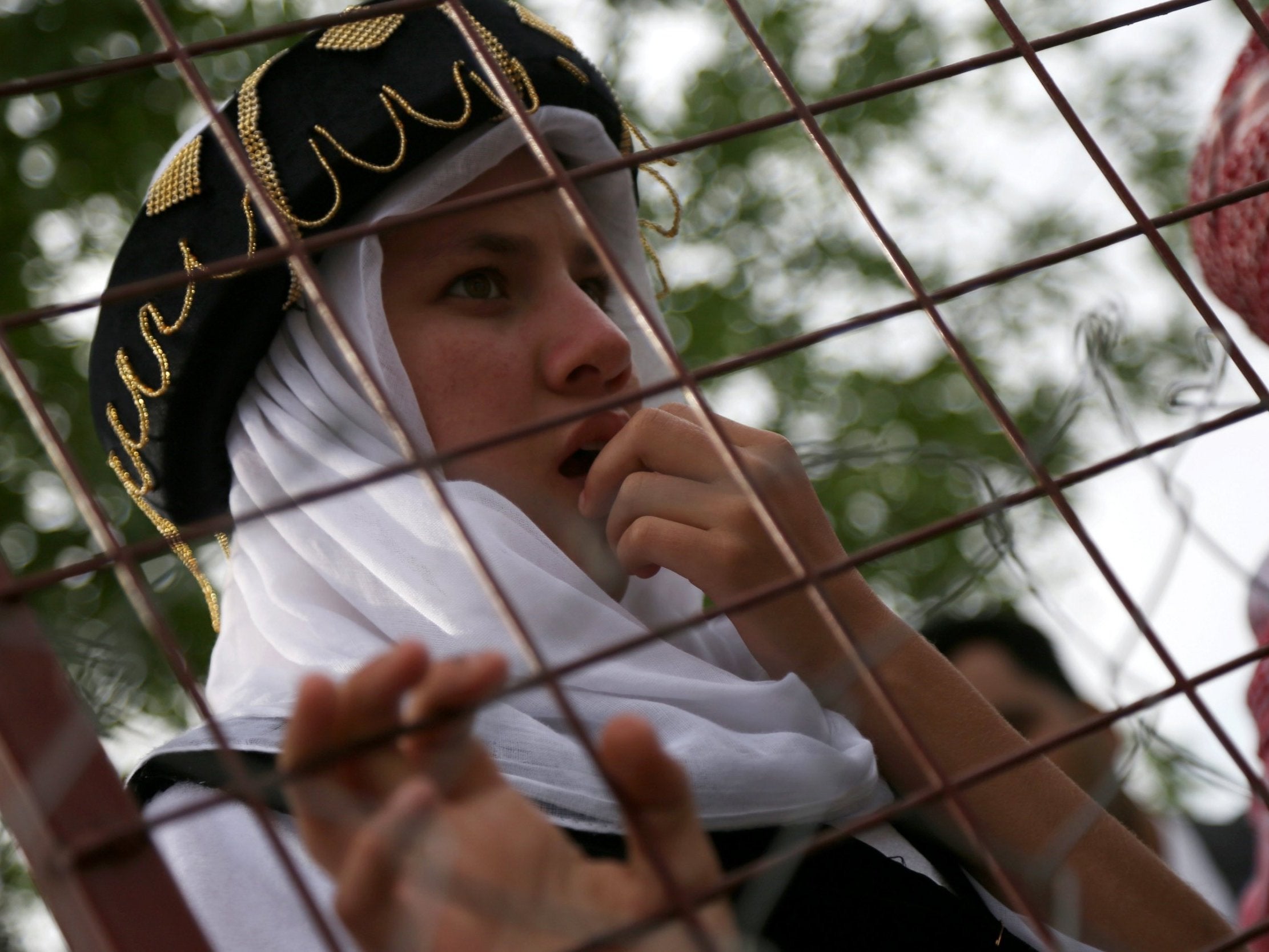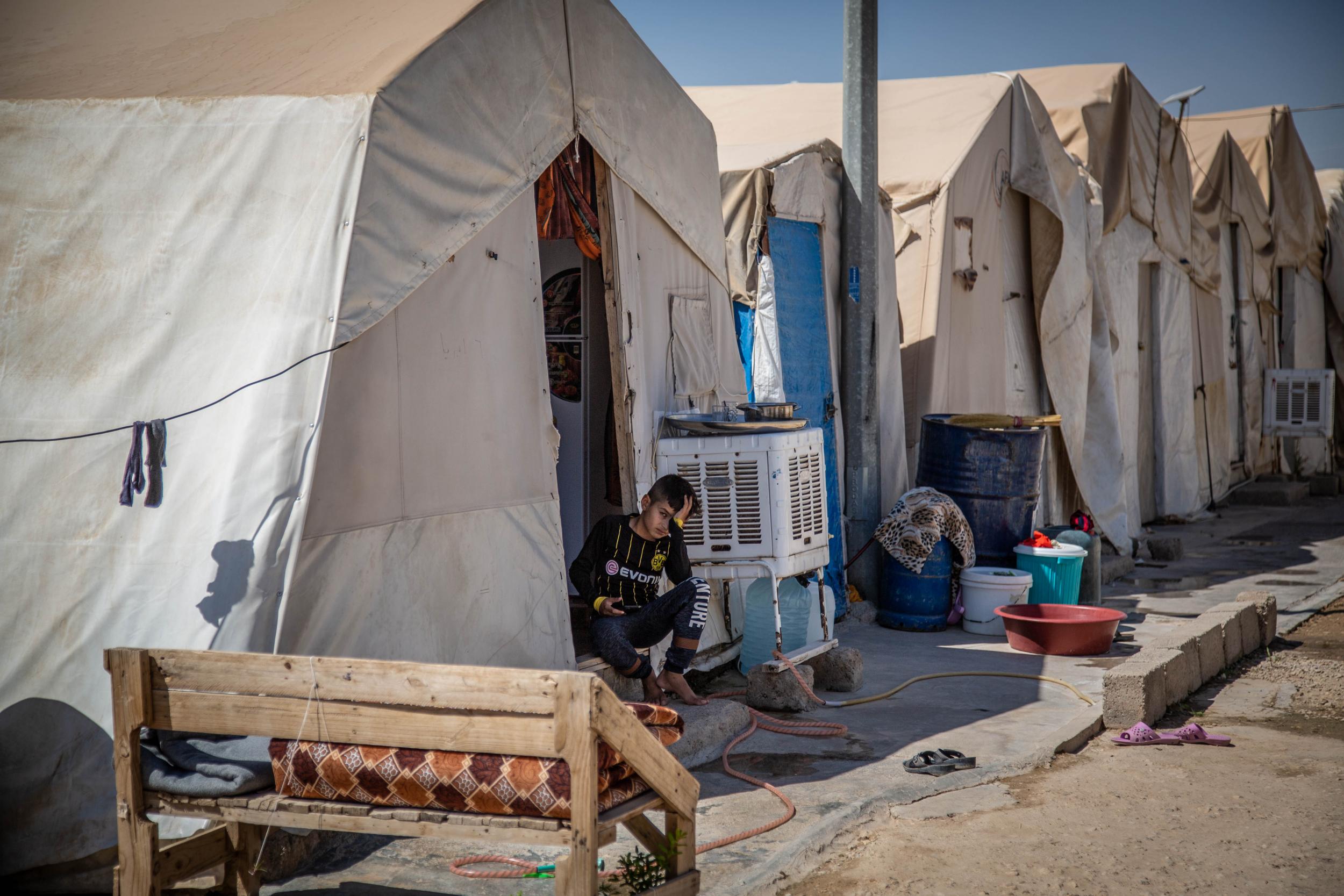Slave trade: Fleeing Isis militants sell Yazidi captives to fund escape from terror group
Militants desperate to escape the crumbling caliphate have made millions of dollars to fund their flight selling back their slaves to desperate families, writes


He had not dared to hope until the pixelated video on his mobile sprang into life and there she was, looking back at him, talking.
Ali, an Iraqi Yazidi man had been sent the one-minute clip of his niece from an Egyptian Isis fighter based in Deir Ezzor, eastern Syria.
It was the first time anyone in the family had seen Layla, now aged 13, since she was separated from her family three years earlier. Every one of Layla's female relatives had been kidnapped as slaves by the militants when they outran the family car as they tried to flee Sinjar in August 2014.
Dressed in a strange hooded black cloak, with her hair pulled back, the teenager’s eyes flicker repeatedly to the left, where off-camera an unknown person appears to prompt her.
“I just want to come home. I’m ok. Can you organise it please uncle?” she asks, her sentences tripping over each other in a harried staccato.
“Please. Do what they say.”
Fast forward three months and Layla is seated, transformed, inside a corrugated-iron shack in an Iraqi displacement camp in Duhok where her extended family now live. She arrived in Iraqi Kurdistan just three days beforehand after enduring a gruelling trip with smugglers all the way from Deir Ezzor. The family were relieved to find out from doctors that she had not, like most of the kidnapped Yazidi women and girls, been held as a sex slave.
She told The Independent she was instead kept as a servant and regularly whipped with electrical cables and water hoses.
Her uncle paid the Egyptian militant $22,000 for her freedom. In fact, the family has paid Isis fighters a staggering $100,000 to buy back seven relatives, including Layla and her mother who was rescued a year early. It has plunged them into unimaginable debt: they owe money to everyone they know.
“The Isis fighter reached out to us first through Facebook then Telegram,” the weary 42-year-old says, speaking in low tones so that his niece, who was playing in the corner, could not hear.
“He just said he wanted to get the money for the girls, so he could use the funds to escape Isis and leave for Turkey.
“This is what they all want now.”
With Isis increasingly corralled into a shrinking “caliphate” in Syria, militants looking for money to escape the jihadi group are exploiting desperate Yazidis by selling back their slaves to raise the funds.
Yazidi activists estimate that millions of dollars have been paid to fighters to secure the release of different captives.
“Isis fighters have become more and more desperate and want to leave the group – so that is why they are selling the girls,” says Talal Mourad, a Yazidi activist and journalist, who tries to help displaced families in the camps.
“The number of girls returning has definitely increased. Last week alone five members of the community, including two children, were liberated and bought back,” he adds.
Typically, the fighters ask for no less than $10,000, Mourad continues. If there are children involved they often charge $30,000 for the family as a “package”.
He said Isis fighters were also buying girls from other militants and selling them back to families for a profit.
“It’s like they are trading in slaves. We know a lot of money is going to Isis but there is no other way to liberate people. No one is helping the Yazidi people, no one is looking for the missing people. What would you do if it was your daughter or mother?”
In total, nearly 10,000 of the ethnic and religious minority were slaughtered or captured in a matter of days in early August 2014, when Isis raged through Sinjar, according to a study published a few months ago in weekly journal PLOS Medicine.
Yazidis were subject to the most brutal treatment by the jihadi fighters who regard them as “devil worshippers” for their belief in a peacock-shaped angel. Thousands were shot dead, burnt alive and beheaded.
Women and girls as young as 12 were taken as sex slaves. Others like Layla were taken away from their mothers and made to work as servants.
Despite the fact that Isis is largely defeated in Iraq and its influence is waning in Syria, there are thought to be at least 3,000 Yazidi women and children still in their captivity.
Thousands more, like Layla’s relatives, live in squalid displacement camps in northern Iraq. They are too terrified to return home to Sinjar due to the presence of their Sunni Arab neighbours, who they suspect of collaborating with Isis and facilitating the massacres. The Iraqi authorities and the local Kurdistan government have few resources to manage the massive displacement crisis in Iraq: more than two million people are currently displaced in the country.
With no one to help find their loved ones, they have turned to unorthodox ways to locate them, working through a complex network of rescuers and smugglers.
One of the most famous rescuers is Abdullah Shrem, who helped liberate little Layla. Before the war, the Yazidi beekeeper used to live in Aleppo, working as an auto trader, until Isis roared into his life.
Shrem’s story starts in 2014 when his own sister and niece were captured by Isis and held as sex slaves. In desperation, he reached out to everyone he knew to locate them and found an unlikely ally in the cigarette smugglers who were risking their lives to get the contraband into Isis territory.
“They were smugglers, so they know the routes and since they smuggled cigarettes, Isis hated them. A love of money was what I relied on. I promised to give them double as much as they would usually make. In the end we managed to rescue my sister and her daughter in 2014,” he says.

After that he helped families who were facing similar troubles. Not all rescues are secured through paying off fighters. Shrem mainly tries to sneak women out secretly and has even helped wives of Isis fighters who want to escape.
“Having been in their shoes already, I did not want to turn them down,” he says.
Since 2014, he says he has rescued over 380 Yazidis using a 10-person network of brave souls. It is extremely dangerous work: over the last four years Shrem has lost six members of his team, including five men and a woman who were executed by Isis during operations to rescue detained women and children in Aleppo, Raqqa and Abu Kamal. He himself has faced death threats from Isis, who sent him photos of his own car as a warning.
Isis now ask the smugglers to help them get to Turkey in exchange for sparing the lives of detainees
He say he has noticed a change as Isis territory has shrunk. Militants are now demanding their freedom as payment for the safe release of their Yazidi captives, something Shrem refuses to do.
“Isis fighters will try to negotiate their escape when we are on a mission,” he continues.
“They now ask the smugglers to help them get to Turkey in exchange for sparing the lives of detainees and the smugglers themselves,” he adds.
Smuggling costs – sometimes separate to the funds demanded by Isis – have also shot up as the journey has become longer and riskier. In the past, a 10-man team would ask for just $2,000 to buy gas, weapons, food, satellite phone, and other equipment. Now as the stakes are higher, and the journeys longer, that bill is topping a staggering $15,000.
In a bleak and dusty IDP camp in Duhok, Narin, who was also sold into sex slavery, describes what happened to her after Isis militants stormed her family farm in 2014, and separated the women from the men and the elderly.
Sitting on the floor of a tent, the 25-year-old speaks with a blank face about the unimaginable horrors she has seen.
I was sold nine times. The youngest girl for sale was just 12 years old
When Isis first came, all her Yazidi male relatives were slaughtered on the spot. The young girls were then dragged screaming to a nearby hall. Sisters were separated from sisters, daughters were ripped from their mothers. The militants lined them up in order of beauty, and so price.
The hardest part was being constantly handed from one fighter to another, not knowing how terrifying the next house would be.
“In total I was sold nine times,” she says, the flat brutality of her words forcing every head in the room to bow.
“The youngest girl for sale was just 12 years old.”
Her brother Sultan finally received a phone call in August 2016, two years into her captivity, and after she had been moved from Sinjar to Mosul and then Raqqa.
The Isis fighter who “owned” Narin was calling the family as he wanted to leave Syria but needed money to escape.
Sultan said the fighter – who was from Algeria – wanted as much as $20,000 for Narin’s freedom but only agreed to release her once the funds had been received.
“We were using Telegram [mobile phone application], every sentence of the conversation was being erased as he wrote it. We didn’t agree on delivery details, we just couldn’t trust him,” he says.
Eventually the fighter sold his sister onto a Saudi man who “traded in women” and had four women in his charge.
The Saudi fighter agreed that payment would be sent after delivery but kept the three other women as hostages.
“He said if the money doesn’t reach him the other girls will be killed. So one by one the girls were released, until they reached my sister.”
In October 2016, after a gruelling journey through frontlines, deserts and mountains, Narin arrived in Duhok: a day that Sultan calls “magical”.
But the relief was short-lived, the family now live in a sprawling IDP camp with limited electricity, no financial or psychological support and little hope for the future. Like every family in this camp, they are still missing relatives (eight in total) and cannot return home to Sinjar.
Narin, meanwhile, has been left on her own to punch through her trauma and try to rebuild her life.
“We had been abandoned by everyone. There is no support from the international community or the Iraqi government. Even though we repeatedly ask, nobody helps us,” she says.
"There is nothing to go home for. The house is destroyed, there are mass graves all around our farm. The world once cared and now it doesn’t.”
A few miles away, in a ramshackle apartment, a similar story was told by another girl Nadia, who was sold as a sex slave to a middle-aged fighter in 2014 when she was just 12.
Nineteen members of Nadia’s extended family were taken by Isis, who shot dead most of the men and sold the women, including her two older cousins, who sit beside her.
Nadia, now 16, opens up about her ordeal, unprompted.
“When they sold me for the first time I tried to commit suicide. I was just 12 years old and they raped me,” she says.

“I had a tattoo of my father and my mother’s initials – the militants said it was forbidden and cut the tattoo off me with a knife,” she adds.
She has received no psychological support and her family are penniless. Her brother and father are still missing, presumed dead. Feeling isolated and abandoned in Iraq, the entire family wants to emigrate to Australia: a dream echoed by every family The Independent spoke to.
Back at Layla's house, the family say in that way they have been lucky. Layla’s mother, who was freed a year before her daughter, was granted asylum in Canada with her youngest child. The family’s main hope now is to arrange the reunification of the family.
Layla calls her mother on a battered mobile and the cousins crowd around giggling. It is hard to imagine this normal looking teenager, in a glittery pink top, was just a week ago living under one of the most brutal regimes in the world.
“I thought I would never escape – I thought that would be my life forever,” Layla says after hanging up.
“I haven’t seen my mother since 2015 – I just want to be reunited with her. We can’t stay here, there is no hope.”
*All the names have been changed to protect the identities of the interviewees
Join our commenting forum
Join thought-provoking conversations, follow other Independent readers and see their replies
0Comments